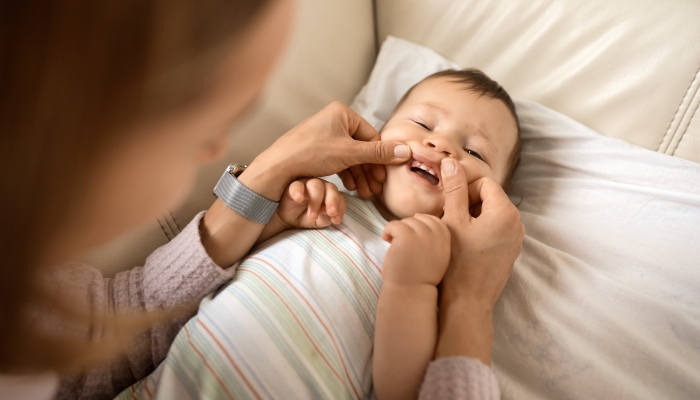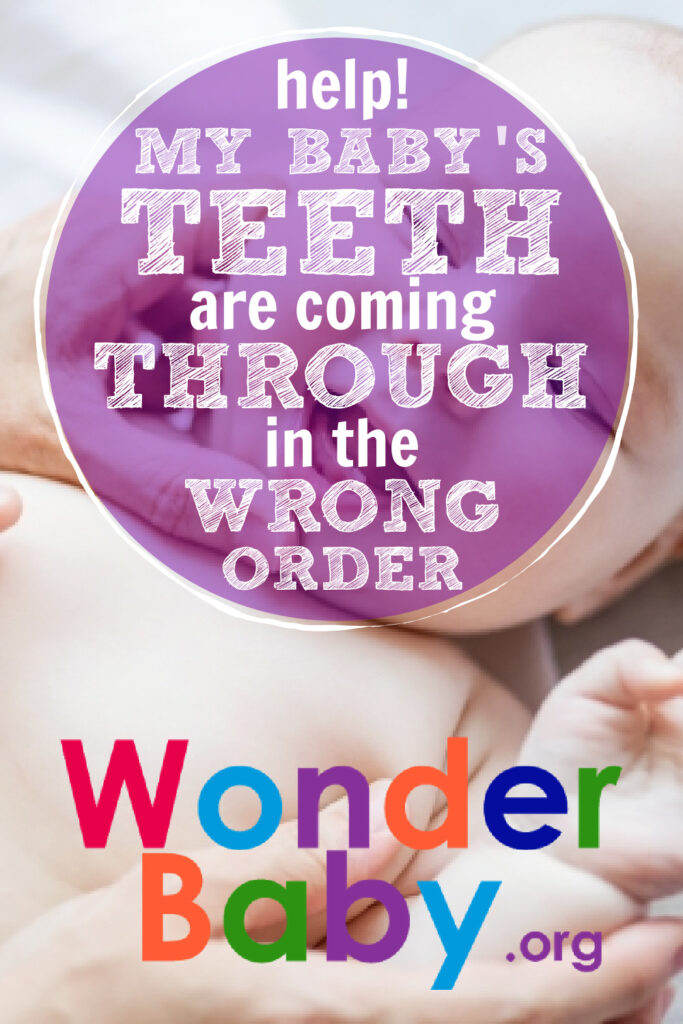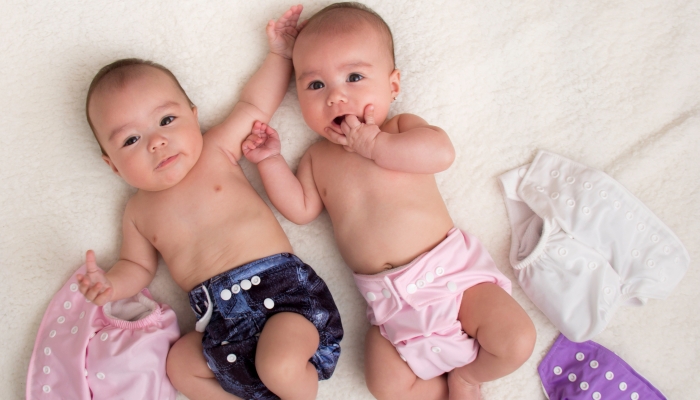Help! My Baby’s Teeth Are Coming Through In the Wrong Order

- While all babies develop differently, there is a general timeline and order for tooth eruption that is most common.
- As long as their baby teeth come in eventually, the order shouldn’t affect their dental health.
- Baby teeth normally fall out in the same order they came in.
When your little one’s teeth erupt, it’s a big deal for everyone in the house.
One day you notice your baby is more fussy than usual. Then you find yourself wiping drool from their face all day. Maybe you also notice a drool rash and your baby putting their hands in their mouth.
Then suddenly you see one tooth erupt slightly with a white little line in the gums. Teething has begun!
The first tooth is a major milestone in your baby’s development. Just like crawling or walking, the arrival of your baby’s first teeth is exciting and challenging all at the same time. This new milestone can also cause concern when you think something is off.
If you have noticed your baby’s teeth coming through in the wrong order, don’t worry. We’re going to help walk you through your child’s baby teeth development.
Why Would My Baby’s Teeth Come In Out of Order?
There may not be much of a reason for your child’s teeth coming in the wrong order. All little ones develop teeth differently. Some babies get teeth early, while others don’t get teeth until closer to their first birthday.
Likewise, some babies get their teeth in the typical order while others don’t. Sometimes babies with genetic conditions, nutritional deficiencies, or who were born prematurely might have delays in tooth growth. However, this still might not affect the order they come in.
One other reason for a delay in tooth eruption is thick gums. If your baby has gums that are too thick, their teeth may not be able to surface. In this case, dentists are able to make small incisions to help them erupt.
The bottom line is that you shouldn’t be too concerned about the order of your little one’s teeth. The most important thing is that they eventually all come in!
What Is the Normal Order of Teeth Appearance in Babies?
While all little ones develop differently, there is a general timeline and order of teeth coming in that is most common.
The two bottom front teeth, also known as the lower central incisors, are usually the first to come in. These are typically followed by the top two teeth, the central incisors. After all incisors are in, you can expect your baby to get their first molars, which are the large teeth in the back of their mouths.
The second to last tooth set to come in are the canines. These are the pointy teeth on either side of the lateral incisors. This is followed by the set of second molars, which ends the two-year teething period.
This chart may help:
| Order | Teeth | Age Range |
| First | Bottom Central Incisors | 6-10 months |
| Second | Top Central Incisors | 8-12 months |
| Third | Top Lateral Incisors | 10-13 months |
| Fourth | Bottom Lateral Incisors | 10-16 months |
| Fifth | Top Front Molars | 13-19 months |
| Sixth | Bottom Front Molars | 14-18 months |
| Seventh | Top Canines | 16- 22 months |
| Eighth | Bottom Canines | 17-23 months |
| Ninth | Bottom Back Molars | 22-31 months |
| Tenth | Top Back Molars | 25–33 months |
There are more teeth that come later in life. Your child will get three more sets of molars. The first two sets come in around the ages of 6 and 12 years old.
The third set is known as wisdom teeth. These usually arrive anywhere between 17 and 21 years old. Sometimes dentists will extract these teeth from the mouth to prevent overcrowding.

What Happens if My Baby’s Teeth Don’t Erupt in Order?
If your baby’s teeth don’t erupt in the normal order, don’t panic. This likely won’t cause any harm.
Sometimes you might see the upper teeth emerge before the lower teeth. Or your baby might have delayed tooth eruptions. As long as their teeth begin erupting eventually, the order shouldn’t affect their dental health.
In very few cases when teeth emerge in the wrong order it causes issues with proper alignment. If you are concerned about your baby’s tooth development, talk to a pediatric dentist. They will be able to tell if their tooth eruption is on track and help put your mind at ease.
Is There Anything I Can Do to Make My Baby’s Teeth Come in the Proper Order?
There is nothing you can do to make your child’s teeth erupt in a certain order. Sometimes genetics determines this before they are born.
Occasionally, nutritional deficiencies cause a delay in baby teeth eruption. In this case, ensuring your child gets proper nutrition is key.
A diet rich in minerals like calcium, magnesium, and phosphorus, as well as protein helps build strong teeth. A variety of fruits and vegetables will provide essential vitamins for oral health like A, D, and C. Offer your child a diet low in sugar and rich in whole grains, protein, and produce.
You can also help ensure that their teeth are healthy by:
- Starting them on a fluoride supplement as soon as their first tooth comes in.
- Brushing their teeth twice a day with an amount equal to a grain of rice of fluoridated toothpaste. Begin this as soon as their first tooth comes in.
- Taking them to the dentist for regular checkups and cleanings starting at one year old.
When Should I Worry and What Can I Do?
Most of the time there is no reason to worry. However, there are a few oral health signs that may point to a more serious issue such as tooth decay or gum disease. If your baby has any of the following symptoms, talk to their pediatrician or dentist:
- Yellow spots or brown spots on teeth (Or other signs of tooth decay)
- Oddly sized or shaped teeth
- Extremely widely spaced teeth (Some space is normal)
- Baby teeth haven’t erupted by 12 months old
- Puffy, red, bleeding gums (Or other signs of gum disease)

FAQs
Is it normal for babies to have gaps in their front teeth?
Gaps between baby teeth are common and usually nothing to worry about. These are particularly common in between the bottom front teeth and the top two teeth.
In fact, gaps are a sign of healthy tooth alignment. The gaps allow for space as the permanent teeth erupt around 6 years old.
In most cases, the gaps will close on their own as your child’s mouth grows. However, if the gaps do not close by the time your little one gets their permanent teeth, they may need braces to correct the alignment.
Is it normal for babies to get side teeth first?
Babies usually get their front teeth in first. However, every child is different and some may get their side teeth first instead. It’s important to remember that your child is fine as long as all the baby teeth eventually come in.
Do teeth always fall out in the same order?
Baby teeth normally fall out in the same order they came in. The adult teeth take time to travel to their place. When they push against the baby teeth, children’s teeth start loosening.
Kids usually lose the lower central incisors first. This is often followed by their two front teeth, or their upper central incisors. Their upper canines and second molars are often the last to leave.
The primary teeth, or baby teeth, start to fall out around age 6 to 7. This continues until around age 12. By age 21, most people have their full set of 32 permanent teeth.
Early tooth loss usually happens in kids who also got their teeth in early. The opposite is also true. Late tooth loss usually happens in children who got their teeth in late.
What is the difference between primary and permanent teeth?
Primary teeth, or baby teeth, are the first set of teeth your child gets. These are sometimes referred to as milk teeth as they can appear while your baby is still breastfeeding or bottle feeding. These small teeth hold a place in your baby’s gums for permanent teeth.
They are smaller than permanent teeth and have thinner enamel. This gives the appearance of the “pearly whites” children are known for. Their roots are also smaller, allowing them to loosen easily.
Permanent teeth are larger and have a thicker enamel. These are not replaced by other teeth. With proper oral care, your child will keep these teeth for life.
What if my baby’s teeth are coming in crooked?
If your baby’s teeth are coming in crooked, there’s usually no need to fret. Baby teeth can come in crooked for a variety of reasons. The most common reason is genetics.
As a child’s mouth develops, their jaw grows. This growth changes the formation of their teeth and gums. Oftentimes, the baby teeth will straighten out on their own as the jaw expands.
If your child’s teeth don’t straighten, that’s okay. It’s not uncommon for permanent teeth to come in straight even if the baby teeth were crooked.
If you are concerned about your baby’s crooked teeth, talk to their pediatric dentist.

The information WonderBaby provides is not intended to be, and does not constitute, medical or other health advice or diagnosis and should not be used as such. Always consult with a qualified medical professional about your specific circumstances.
Related Posts

Development, Special Needs
How to Track Milestones for Developmentally Delayed Babies
Parents of developmentally delayed babies can explore practical tools and strategies to track milestones, celebrate progress, and support their child’s unique developmental journey.

Fine and Gross Motor
5 Alternatives to Tummy Time for Babies with Motor Development Challenges
Does your baby struggle with tummy time due to motor development challenges? These alternatives to tummy time will offer the same benefits.

Development
Should Twins Share a Room?
Wondering if your twins should share a room? We’ll explore the pros and cons of room-sharing for twins right here before you make your decision.